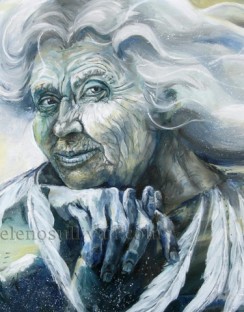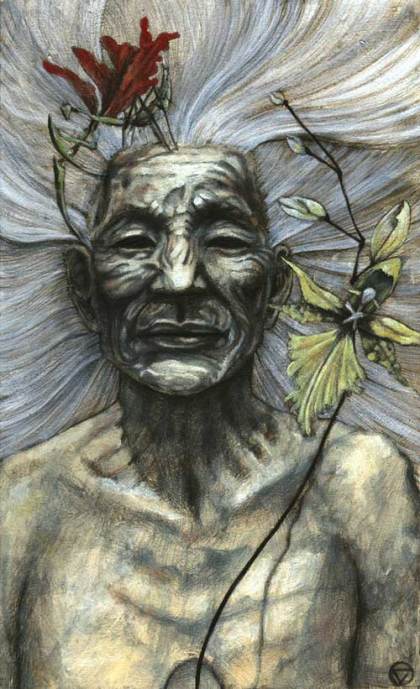In Gaelic mythology ‘Cailleach is’ Irish for “hag”. A divine hag, a creator deity and weather deity, and an ancestor deity. In Irish lore, she goes under many names, including Digde, Milucra, Birog, Buach, etc. The word itself is found as a component in many Terms, such as cailleach-dhubh (“nun”); cailleach-oidhche (“owl”); cailleach feasa (“wise woman, fortune-teller”); and cailleach phiseogach (“sorceress, charm-worker”).

The Cailleach displays several traits that would be typical of winter, herding deer, she fights spring, and her staff freezes the ground. Alongside and in partnership with the goddess Brighde, the Cailleach is seen as a seasonal deity or spirit, ruling the winter months between Samhain (1 November or the first day of winter) and Bealtainn (1 May or the first day of summer), while Brìghde rules the summer months between Bealltainn and Samhainn. It is said that the Cailleach turns to stone on Bealltainn and takes human form again on Samhainn, just in time to rule over the winter months.
Depending on local climate, the transfer of power between the winter goddess and the summer goddess is celebrated any time between Là Fhèill Brìghde (1 February) at the earliest, Latha na Cailliche (25 March), or Bealltainn (1 May) at the latest, and the local festivals marking the arrival of the first signs of spring may be named after either the Cailleach or Brìghde. Là Fhèill Brìghde is also said to be the day when the Cailleach gathers her firewood for the rest of the winter. Legend has it that if she intends to make the winter last a good while longer, she will make sure that the weather on 1 February is bright and sunny so she can gather plenty of firewood to keep herself warm in the coming months. As a result, people are generally relieved if Là Fhèill Brìghde is a day of foul weather, as it means the Cailleach is asleep, will soon run out of firewood, and therefore winter is almost over.
Traditionally, in Ireland, the first farmer to finish the grain harvest made a ‘Corn Dolly’, representing the Cailleach, from the last sheaf of the crop. The figure would then be tossed into the field of a neighbour who had not yet finished bringing in their grain. The last farmer to finish had the responsibility to take in and care for the corn dolly for the next year, with the implication that they would have to feed and house the hag all winter, so the competition was fierce to avoid having to take in the Old Woman.
There are some who believe the Old Irish poem, ‘The Lament of the Old Woman of Beara’ speaks of Cailleach. It was said that she had fifty foster-children in Beare. She was said to have had seven periods of youth one after another so that every man who had lived with her came to die of old age, and her grandsons and great-grandsons were tribes and races.
